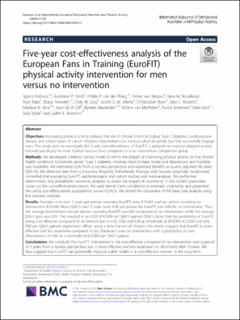Five-year cost-effectiveness analysis of the European Fans in Training (EuroFIT) physical activity intervention for men versus no intervention
Kolovos, Spyros; Finch, Aureliano P.; van der Ploeg, Hidde P.; van Nassau, Femke; Broulikova, Hana M.; Baka, Agni; Treweek, Shaun; Gray, Cindy M.; Jelsma, Judith G.M.; Bunn, Christopher; Roberts, Glyn; Silva, Marlene N.; Gill, Jason M. R.; Røynesdal, Øystein; van Mechelen, Willem; Andersen, Eivind; Hunt, Kate; Wyke, Sally; Bosmans, Judith E.
Peer reviewed, Journal article
Published version
Permanent lenke
https://hdl.handle.net/11250/2731865Utgivelsesdato
2020Metadata
Vis full innførselSamlinger
- Publikasjoner fra CRIStin [111]
- Tidsskriftartikler [94]
Originalversjon
International Journal of Behavioral Nutrition and Physical Activity. 2020, 17 (1), . 10.1186/s12966-020-00934-7Sammendrag
Objectives: Increasing physical activity reduces the risk of chronic illness including Type 2 diabetes, cardiovascular disease and certain types of cancer. Lifestyle interventions can increase physical activity but few successfully engage men. This study aims to investigate the 5 year cost-effectiveness of EuroFIT, a program to improve physical activity tailored specifically for male football (soccer) fans compared to a no intervention comparison group. Methods: We developed a Markov cohort model in which the impact of improving physical activity on five chronic health conditions (colorectal cancer, Type 2 diabetes, coronary heart disease, stroke and depression) and mortality was modelled. We estimated costs from a societal perspective and expressed benefits as quality adjusted life years (QALYs). We obtained data from a 4-country (England, Netherlands, Portugal and Norway) pragmatic randomised controlled trial evaluating EuroFIT, epidemiological and cohort studies, and meta-analyses. We performed deterministic and probabilistic sensitivity analyses to assess the impact of uncertainty in the model’s parameter values on the cost-effectiveness results. We used Monte Carlo simulations to estimate uncertainty and presented this using cost-effectiveness acceptability curves (CEACs). We tested the robustness of the base case analysis using five scenario analyses. Results: Average costs over 5 years per person receiving EuroFIT were €14,663 and per person receiving no intervention €14,598. Mean QALYs over 5 years were 4.05 per person for EuroFIT and 4.04 for no intervention. Thus, the average incremental cost per person receiving EuroFIT was €65 compared to no intervention, while the average QALY gain was 0.01. This resulted in an ICER of €5206 per QALY gained. CEACs show that the probability of EuroFIT being cost-effective compared to no intervention is 0.53, 0.56 and 0.58 at thresholds of €10,000, €22,000 and €34,000 per QALY gained, respectively. When using a time horizon of 10 years, the results suggest that EuroFIT is more effective and less expensive compared to (i.e. dominant over) no intervention with a probability of cost-effectiveness of 0.63 at a threshold of €22,000 per QALY gained. Conclusions: We conclude the EuroFIT intervention is not cost-effective compared to no intervention over a period of 5 years from a societal perspective, but is more effective and less expensive (i.e. dominant) after 10 years. We thus suggest that EuroFIT can potentially improve public health in a cost-effective manner in the long term.

